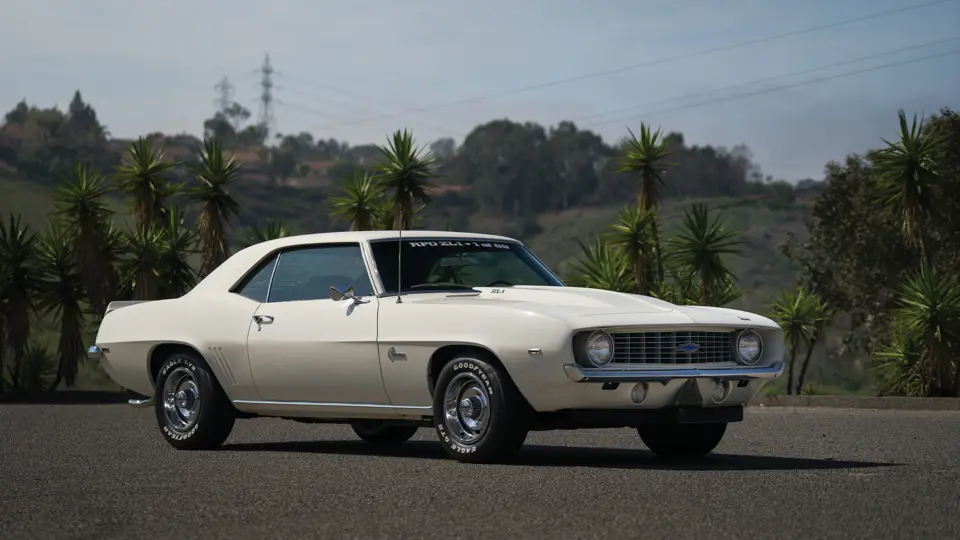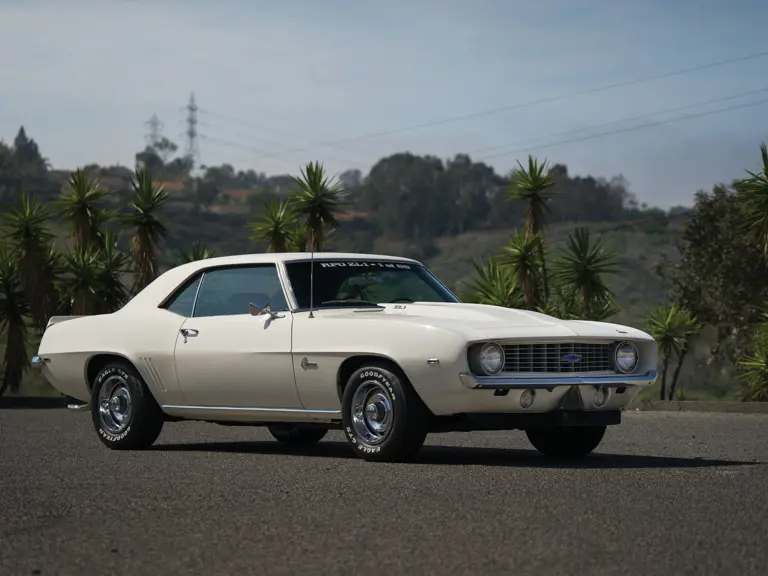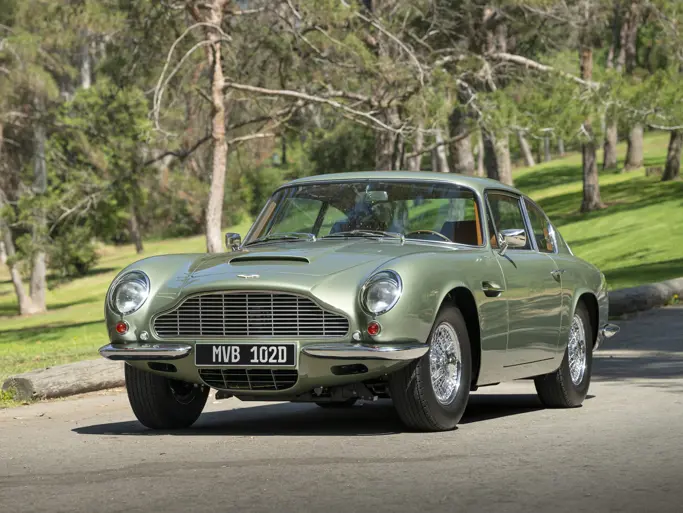 | Fort Lauderdale, Florida
| Fort Lauderdale, Florida

1969 Chevrolet Camaro ZL1
{{lr.item.text}}
$404,250 USD | Sold
{{bidding.lot.reserveStatusFormatted}}
- 427-cid, 430-hp aluminum big-block engine
- M22 "Rock Crusher" four-speed manual transmission
- Production #53 of 69 total ZL1's built
- One of three ordered in Dover White
- One of 12 built with M-22 transmission
- COPO 9560
- Functional cowl hood
- Heavy-duty radiator
- Chambered exhaust
- Transistorized ignition
- Formerly owned and restored by Floyd Garrett Muscle Car Museum
- "Correct ZL1 replacement block"
- Drag racing history
- Has E.T. time slips & period photos
- NHRA record holder
- Very rare
- Correct throughout
Central Office Production Order (COPO) – arguably some of the most revered letters for aficionados of the musclecar. Without question, COPO was responsible for some of the most remarkable and fastest cars of the late-1960s and early 1970s musclecar era. Thanks to General Motors’ many internal edicts to limit performance, COPO was a way of circumventing the corporate red tape and building cars that the public wanted, but GM didn’t allow dealers and the public to order. F-bodies (Camaros and Firebirds) and A-bodies (Chevelles, GTOs, 4-4-2s and Gran Sports) were limited by corporate rule to engines no larger than 400 cubic inches. With Ford building Cobra Jet 428 Mustangs and Cougars and Chrysler producing 440 and 426 Hemi ’Cudas and Challengers, GM was forced to react.
When the Camaro was introduced in 1967 as a competitor to Ford’s popular Mustang, the biggest motor available was the L78 396-cid, 375-hp “big-block,” even though Chevrolet offered its 427-cid variant in the Corvette and Impala SS. The 427 was only 30 or so cubic inches of displacement larger, and its external dimensions were identical to the 396. So what was the big deal? In Chevy’s case it was a matter of power-to-weight ratio. It was an unspoken rule – the Corvette had to be the most powerful, and thus the fastest, of all Chevrolets. You couldn’t have the less-expensive Camaro out-performing its costlier and more sophisticated brethren. To some, this prompted the question, “Why not a 427 Camaro?”
COPO
A Central Office Production Order was really nothing new at GM; it was Chevrolet’s way of filling unusual orders through its Fleet and Special Order Department. Quite simply, if you wanted to order municipal vehicles or 100 taxis in a special color, you did it through the local dealer via a COPO form. COPO rules were simple: you couldn’t order just one car (ten was the minimum order), the parts had to be readily available, and the cars and parts had to be compatible (i.e. you couldn’t put a 427-cid V-8 in a six-cylinder Nova). Enterprising dealers (and Chevrolet executives) came to realize that they could get factory “hot rods” by ordering specially-equipped cars through the COPO program. COPOs did not require the approval of upper-level GM management.
Perhaps one of the first noteworthy examples was Fred Gibb Chevrolet, which wanted to drag race automatic transmission-equipped L78 396-cid, 375-hp V-8 Novas in 1968. The problem, however, was the Chevy did not offer this combination. Enter Vince Piggins at Chevrolet (the man behind the Z28 Camaro) who saw to it through the COPO process that 50 L78 Novas were produced with Turbo-Hydramatic 400 transmissions, thereby satisfying NHRA stock class production requirements. Problem solved.
Other dealers (and GM brass) began to take notice, most notably Nickey Chevrolet in Chicago, Illinois, Dana Chevrolet in Southgate, California, Yenko Chevrolet in Canonsburg, Pennsylvania, Berger Chevrolet in Grand Rapids, Michigan and Baldwin Chevrolet in Long Island, New York. These dealers envisioned that these special cars would help promote their respective dealerships before thousands of prospective customers by campaigning the cars in drag racing competition while gaining important exposure through magazine and news coverage.
COPO ZL1 Camaro
The process was really quite simple. By specifying COPO Code 9561 (9562 for a Chevelle), dealers could order an L72-equipped 427 Camaro. However, COPO Code 9560 belonged to some really exotic hardware. It provided dealers with a race-ready performance car equipped with the all-aluminum ZL1 427 conservatively rated at 430-hp.
Author David Neuhardt, in his book American Muscle Supercars, best described the ZL1 Camaro by using a supply of unending yet appropriate superlatives.
“Rare, subtle, and stupid-fast, the 1969 Camaro ZL1 used an aluminum 427 cubic inch race engine to pound humility into everyone else. . . With open headers, the engine would dyno at 575 horsepower, yet its rated output of 430 was tacit acknowledgement that the insurance companies were starting to exert pressure on Detroit. . . From almost any angle, a ZL1 Camaro was a visually underwhelming machine. There were few external markings to hint at the thermonuclear device under the hood. . . The extra cost of a ZL1 was evidenced under the hood, not in the interior. Bone stock, the ZL1 driver sat in an environment identical to what the owner of a six-cylinder Camaro would enjoy. One sounded like it was ready for a trip to the grocery store, the other sounded like it was in the staging lanes.”
That pretty much sums it up!
Just 69 of the “ultimate Camaros” were produced for the model year: 47 with four-speed manual transmissions and 22 with automatics. Performance was formidable. High Performance Cars magazine tested a ZL1 Camaro and recorded a 13.16 quarter-mile at 110.21-mph. “The ZL1 camshaft was definitely smooth enough to drive on the street, at least in warm weather, though the idle was quite rough. One sober note was the rich-jetted 850-cubic feet per minute Holley carb gave only 5 to 7 miles per gallon in normal street driving. But when you jump on that loud pedal, all is forgiven” One detriment, the magazine went on to point out, and the reason why most ZL1’s ended up in the possession of professional racers, was the price. The test ZL1 from Berger Chevrolet stickered out at a $7,800 price - or roughly twice the price of an L78-equipped SS 396 Coupe. The engine package alone cost $4,160. Reputedly, 50 cars went to dealer Fred Gibb and drag racer Dick Harrell of Kansas City with the other 19 going to various Chevrolet dealers throughout the United States.
High performance COPO cars pretty much went the way of the dinosaur in 1970 when GM dropped its 400-cid V-8 rule for 1970. This allowed Chevrolet to install the LS6 454-cid, 450-hp V-8 in its mid-size Chevelle as optional equipment. It was just a simple tick on the options list that any customer was able to order from their friendly Chevrolet dealer. And, with that COPO, Camaros were relegated to the history books.
#53
According to the caring owner, this car is #53 of the 69 ZL1s built for the 1969 model year. It is also mentioned that cars #53 to #69 were delivered with optional equipment, whereas the earlier 52 cars came equipped only one way from the factory.
Production #53 is reported as the only Code 50 Dover White ZL1 equipped with the M22 “Rock Crusher” four-speed manual transmission. The car was titled at one time to COPO “guru” Ed Cunneen. It was raced in NHRA Pro Stock in 1969 and 1970 and was an NHRA record holder. This very special machine has previously been owned, and in the collections of Floyd Garrett and Robert Lyle. The COPO Camaro ZL1 was restored by Mr. Garrett’s museum personnel and has been “correctly finished throughout, including a correct ZL1 replacement block.”
Among the statistics for this amazing example are it is the 53rd of the 69 similar cars built (plus two prototypes), Dover White with standard Black interior (one of three in Dover White), the car was originally built with the M22 “Rock Crusher” four-speed close ratio manual transmission, and among the COPO 9560 options is the functional cowl hood, heavy-duty four-core radiator with curved neck, transistorized ignition and high performance rear end.
The COPO Camaro began drag racing in 1969, and along with period photos, the E.T. time slips from the strip are included. The ZL1 has a chambered exhaust system and is stated to “run and drive as well as any new ZL1 Camaro. Other equipment includes a rear spoiler, Rally wheels, BFGoodrich Eagle GTII tires, AM radio, dual sideview mirrors and power brakes.
In summary, this “holy grail” of Camaros is restored to a very high level and is presented in a meticulous fashion throughout.. Painted in rare Dover White, it is considered one of the rarest and certainly the most desirable of all COPO Camaros built since the introduction of the first Chevrolet pony car in 1967. It is without question a unique and exciting opportunity to own one of the finest and most expertly restored “blue chip” musclecars offered in recent history. It qualifies as a must-have to the most discerning collector of Chevrolet performance cars.




